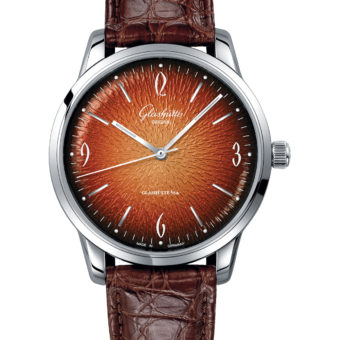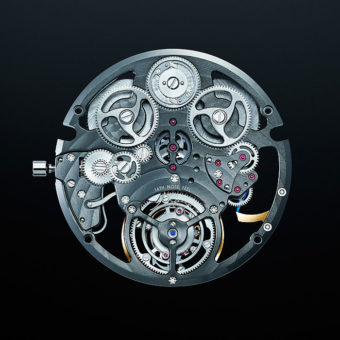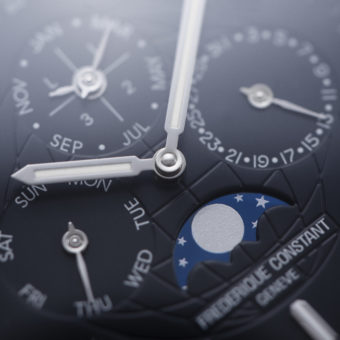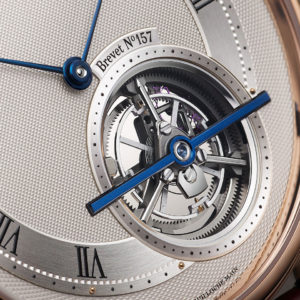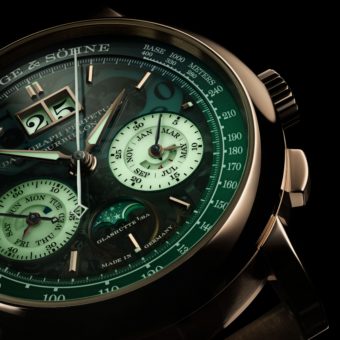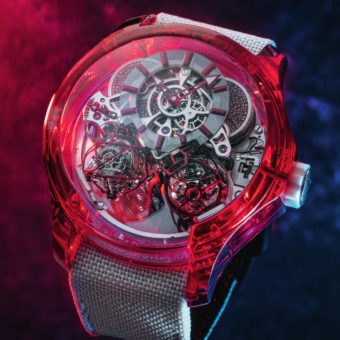
What sets Jean Dunand apart from other luxury watch brands — aside from its extremely limited production and lofty price points — is the fact that each collection has a totally different look, with no “house style” and very few unifying brand characteristics. The only common principle behind each Jean Dunand model, as voiced by the brand’s owners, Thierry Oulevay and Christophe Claret, is that duo’s love of the Art Deco era and its distinctive design principles.
The Jean Dunand Palace, the new model that made its debut at Baselworld, lives up to those principles in a decidedly new and direct way. It is the first Jean Dunand watch in a square case and it takes its name from London’s Crystal Palace, the steel-and-glass architectural marvel built for the Great Exhibition of 1851. The watch takes its design cues from the Industrial Revolution era of 1880 to 1930 — a half-century that gave birth to automobiles, airplanes, skyscrapers, jazz and, of course, the wristwatch. The era also saw the rise of Art Nouveau and the most iconic structure built in that architectural style, France’s Eiffel Tower, whose recognizable latticework is among the many aesthetic tributes to the Industrial Revolution found in the Palace, in both its case and manufacture movement. (Needless to say, the period also coincides with the life of Jean Dunand, the Art Deco pioneer for whom the brand is named.)

Claret and Oulevay were inspired by numerous sources in their development of the watch. One was the Charlie Chaplin film Modern Times, with its classic scene of the Little Tramp literally caught up in the gears of industry. The arrangement of the gears, wheels and bridges, viewed through the transparent caseback, is an homage to that famous factory scene. Another influence was the oval-shaped “Milwaukee Mile” racetrack, which hosted the pioneers of auto racing in the early 1900s. The oval shape is used on the linear GMT indicator on the lower left of the watch and the linear power-reserve indicator on the lower right. The arrow indicator of the former makes two passes through the two vertical 12-hour scales on either side of the oval: when it reaches bottom, the arrow snaps back to the top and reverses itself 180 degrees to chart the 12 hours on the opposite side.

Vintage motorcycles, particularly those made by Indian, inspired the unusual winding mechanism, which transmits power to the barrel by means of a tiny linked chain reminiscent of that on a motorbike. The movement plates are designed to evoke a reinforced cast-iron structure, supported by little pillars. Through the sapphire viewing apertures in the sides of the case, the side-view of the movement resembles a city skyline, or perhaps the foundations of a skyscraper. The apertures are framed by arches that echo those at the base of the Eiffel Tower; the machined, engraved pattern on all four sides of the case suggests the cross-pieces used in the Tower’s construction and in that of other engineering marvels such as the Grand Canyon’s Navajo Bridge. Flourishes inspired by the pistons, nuts, bolts, and gears of locomotives and early submarines, and by the imagery of Fritz Lang’s Metropolis, are also evident in the movement design. The type font used in the nameplates is from the Art Deco era. Simply put, this is a watch that begs for close examination under a loupe.
The Palace movement and an Indian motorcycle

The Palace movement viewed through the side of the case

Palace case detail, and the inspiration


At 38 mm x 36.4 mm and 12.42 mm thick, the movement, Calibre CLA02CMP, made at Claret’s ultra-modern atelier in Le Locle, Switzerland, is as big as some wristwatch cases. It’s manual-wound, with a one-minute flying tourbillon and a monopusher chronograph (operated by a pusher in the crown at 3 o’clock) that counts up to 60 minutes. It’s made up of over 700 individual parts, including 53 jewels. The massive case is 48.2 mm x 49.9 mm, with a titanium caseband and lugs. The bezel, and caseback are available in either rose gold or white gold. The power reserve is 72 hours and the watch is water-resistant to 30 meters. This ticking touchstone to a bygone era — price yet to decided but sure to be in the six figures — is slated for a fall release.


